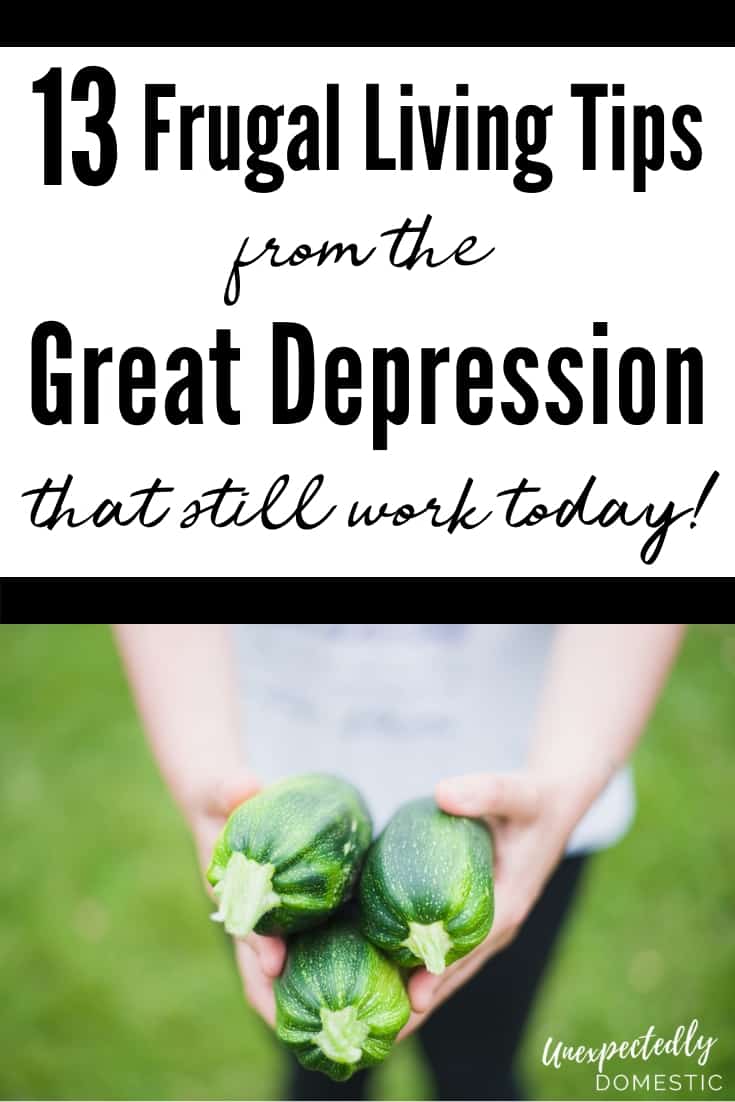The Best Frugal Living Tips from the Great Depression (that we still need today!)

Do you ever think about what it was like to live during the Great Depression? It’s difficult for most of us to imagine years of crippling poverty. The financial lessons that those people had to learn the hard way must have made such a big impact that it stuck with most of them for life.
It got me thinking about some of the resourceful practices they adopted, and which of those frugal living ideas still apply today.
Hopefully none of us will face anything resembling that difficulty. But what if we take inspiration from their struggle and learn ways to stretch our income and make the most of our money?
Let’s look at the best frugal living ideas from the Depression, and how we can still totally use them in the 21st century.
Because being good stewards of our resources never goes out of style!
This post may contain affiliate links. You can view my full disclosure policy here.
So how do you live a frugal lifestyle?
1. Don’t buy everything brand new
Somehow over the years, we’ve turned into a wasteful society. We buy in excess, and throw away in excess, without much thought to what we’ll actually use.
Or if we really have the money to pay for it.
Instead of buying everything brand new, come up with ways you can use something that already exists.
Maybe that’s:
- Making do with what you already have
- Borrowing from a friend or family member
- Purchasing from a thrift store
- Checking Craigslist or another online marketplace for a gently used option
Related: 27 Thrift Store Tricks to Make Your Next Shopping Trip a Massive Success

2. Prepare your own food
With modern conveniences like Uber Eats, it becomes easier and easier to avoid your food-preparing responsibilities.
Unfortunately that comes with a big price. It’s not just the money you spend that Tuesday night when you don’t feel like cooking.
It’s the future value of that wasted money that really costs you.
Money that could have been used to pay down debt with expensive interest. Or invested for retirement.
See, money feels very ‘easy come, easy go’ when you’re young enough to earn more. But one day you won’t be, and you’ll sure wish you had set yourself up better.
Related reading:
- How to Make a Cheap Grocery List: A Step by Step Guide (+10 Money Saving Tricks!)
- 10 Surprising Advantages of Doing a Pantry Challenge
- How to Meal Plan on a Budget (+ cute weekly meal planner!)
3. Don’t pay for things you can do yourself
Part of living frugally means learning how to do things for yourself.
Whether it’s doing your own nails, mowing your lawn, or washing your car.
Many companies are really cashing in on our newfound laziness.
What is something you’re paying someone else to do that you could do yourself?
4. Repurpose what you can
This goes for leftover food, clothing you no longer want, and worn furniture.
Make a plan to eat or repurpose your leftover food. Find a way to mend or upcycle things that could have longer lifespan with just a little imagination.
Consider the old adage “Use it up, wear it out, make it do, or do without” before rushing out to swipe your credit card.

5. Save in advance for the things you want
How we’re going to pay for things often comes as an afterthought. Since lenders hand credit out like suckers at the bank, most of us just assume financing is our only option.
Getting approved for a loan or credit card isn’t a gift! It’s how credit companies make money.
By saving in advance for the things you want, you’ll save a lot of money in interest.
It also helps you think through your purchase more thoroughly. Do you really want it enough to save money for it?
Related: 7 Super Helpful Questions to Ask Yourself Before Buying Something
6. Know the difference between a need and a want
One of the biggest financial lessons from the Great Depression had to be the ability to quickly decipher the difference between needs and wants.
We all know this on some basic level.
But the lines have gotten quite blurred, because there are so many extravagant options for even the simplest things.
Before making a buying decision about something, put it through your own ‘frugality filter’ to see if there is a more economical choice.
Or if you even actually need it at all!
7. Keep a garden
Even if you’re the furthest thing from a green thumb, growing a little garden can be a fun and money-saving venture.
Many veggies are actually very easy to grow. I’ve successfully grown tomatoes, zucchini, bell peppers, and cucumbers with very little effort.
If you don’t have the space or inclination to do a full-blown garden, consider a small herb garden.
You probably never use the whole package of fresh herbs you buy at the store anyway. Plus, it’s just plain fun to be able to pluck off some basil, and add it to your pizza!

8. Use every last drop
Sometimes it feels like the lotion bottle is empty. But then I turn it upside down, and get another week’s worth out of it.
And then I cut it open, and there’s 3 more days’ worth in there.
You can save so much money over time by just using every last drop of every item in your house.
Or try these, they make it easier!
9. Buy what’s in season
You’ll save so much money on your grocery bill if you buy the produce that’s in season.
Not only are the prices at their lowest, but the nutrition value is at its highest.
I created a full guide to exactly what fruits and veggies are in season every month of the year. You can check it out here!
10. Find little ways to earn extra money
In addition to these ideas for living frugally during the depression, many people came up with ways they could earn extra income.
Nothing helps stretch your budget further than more money to work with.
What are some ways you could earn a little side income?
Here are 21 ideas to get you started!
11. Be more mindful of utility usage
This is admittedly something very few of us think about. When’s the last time you thought about how much water or electricity you were using?
Honestly, I almost never do.
But these are things we get charged for, and cutting back will definitely save us money.
Let’s try to be more mindful and less wasteful about our habits.

12. Maintain your belongings
Taking pride in, and good care of, your possessions is kind of a lost art. Many of us don’t keep their homes and cars as clean and tidy as people used to.
In addition to keeping your belongings looking nice, keeping them maintained with proper care keeps them lasting longer.
It shows that you respect the money you spent on those items, and respect yourself enough to take good care of your surroundings.
13. Find inexpensive ways to entertain yourself
In a world where expensive concerts and Disney vacations seem like a basic human necessity, we forget that we can enjoy life without spending money.
Something as simple as a leisurely walk or bike ride, reading a good book, or having a game night at home can actually be really fun.
People who lived during the Great Depression tended to have useful hobbies (like gardening or knitting), instead of expensive ones like golfing or riding horses.
Here are some fun ideas as inspiration:
- 120 Free and Cheap Summer Activities
- 107 Ideas for your Fall Bucket List
- 75 Winter Bucket List Ideas to Help You Enjoy the Season More
- Fun Things to Do in the Spring: 70 Ideas for Your Spring Bucket List
Wrapping it up
Hopefully this list of frugal living ideas from the Depression made you think of little ways you can adjust your life and spending.
These financial lessons are timeless, and ‘cheap living’ doesn’t have to be a drag.
Keep in mind that it will always be the sum of all your little decisions that determines your financial future.
So try your hand at living a more frugal life!
You May Also Like:
- The 13 Habits of Financially Successful People
- How to Live on One Income: 11 Tips for Living Well on a Budget
- 12 Things Frugal People Don’t Do






